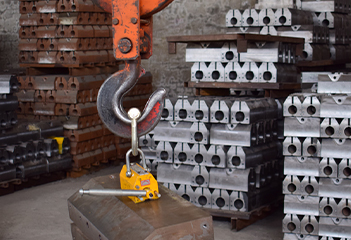porta gantry crane
Understanding Port Gantry Cranes The Backbone of Maritime Operations
Port gantry cranes, also known as container cranes, play a pivotal role in the efficient operation of ports and harbors worldwide. These massive structures are essential for loading and unloading containers from ships, ensuring that the flow of goods through maritime channels remains smooth and effective. As global trade continues to expand, the importance of port gantry cranes cannot be overstated.
Structure and Functionality
Port gantry cranes are characterized by their large, towering frames, which allow them to reach over the sides of ships to lift heavy containers. Typically mounted on rails, these cranes traverse along the dock, positioning themselves over the vessel to perform their tasks with precision. Equipped with telescopic arms, they can handle various container sizes, adjusting their reach according to the container's dimensions and weight.
The primary functionality of a port gantry crane involves lifting containers from ship to shore and vice versa. The cranes are equipped with sophisticated hoisting mechanisms that enable them to lift loads weighing up to 65 tons or more. This capability is crucial, as modern cargo ships are designed to transport thousands of containers at once, necessitating quick and reliable unloading processes to minimize port stay time.
Technological Advancements
Over the years, advancements in technology have significantly enhanced the operational efficiency of port gantry cranes. Automation and smart technologies have been incorporated into their design, allowing for remote operation and better safety measures. Modern cranes often feature advanced sensors and software that assist in the precise maneuvering of containers, reducing the risk of accidents and improving speed.
Moreover, the integration of Artificial Intelligence (AI) and data analytics has revolutionized the management of port operations. Systems can now predict container movements, optimize loading and unloading schedules, and manage the logistics of storage within the port. Such enhancements lead to reduced turnaround times for vessels, translating to lower costs and improved service levels for shipping lines and their customers.
porta gantry crane

Challenges Faced by Port Gantry Cranes
Despite their essential role, port gantry cranes face several challenges. One significant issue is the wear and tear due to continuous use in harsh marine environments. Saltwater and severe weather conditions can lead to corrosion and mechanical failures, necessitating regular maintenance and inspections. Ports must invest significantly in upkeep to ensure these cranes operate safely and efficiently.
Another challenge comes from the increasing size of container ships. The latest generation of vessels, known as Ultra Large Container Ships (ULCS), can carry over 20,000 TEUs (Twenty-foot Equivalent Units). As ships grow larger, so too must the cranes that service them. This trend poses financial and logistical challenges for ports as they need to upgrade existing infrastructure to accommodate these behemoths.
Environmental Considerations
In recent years, the environmental impact of port operations has come under scrutiny. Port gantry cranes, traditionally powered by diesel engines, contribute to greenhouse gas emissions. However, many ports are now transitioning to electric cranes, which are not only more environmentally friendly but also quieter and more energy-efficient. The shift towards sustainable practices is becoming a priority within the maritime industry, enhancing the role of eco-friendly technologies in crane operations.
The Future of Port Gantry Cranes
As global trade continues to evolve, so too will the technology and practices surrounding port gantry cranes. The future will likely see greater integration of automation and AI, leading to even more efficient and safer operations. With an increasing focus on sustainability, we can also expect innovation in energy sources and materials used in the construction and operation of these cranes.
In conclusion, port gantry cranes are a vital component of the global supply chain, significantly influencing the efficiency of maritime logistics. As technology advances and the demands of global trade evolve, these cranes will continue to adapt, ensuring they remain at the forefront of port operations. By understanding their importance and evolving capabilities, stakeholders can better appreciate how instrumental these machines are in the continuous flow of goods across the globe.
-
Unlock Seamless Relocation with Our Heavy Equipment Moving ExpertiseNewsJun.06,2025
-
Unleash Unrivaled Flexibility with Our Adjustable Gantry CraneNewsJun.06,2025
-
Unleash Heavy-Duty Efficiency with Our Industrial Gantry Crane SolutionsNewsJun.06,2025
-
Revolutionize Steel Handling with Our Magnetic Lifter RangeNewsJun.06,2025
-
Master Equipment Mobility with Premium Machinery Mover SolutionsNewsJun.06,2025
-
Elevate Your Material Handling with Magnetic Lifter TechnologyNewsJun.06,2025
-
YS Permanent Lifting Magnets: The Smarter Way to Handle SteelNewsMay.22,2025
